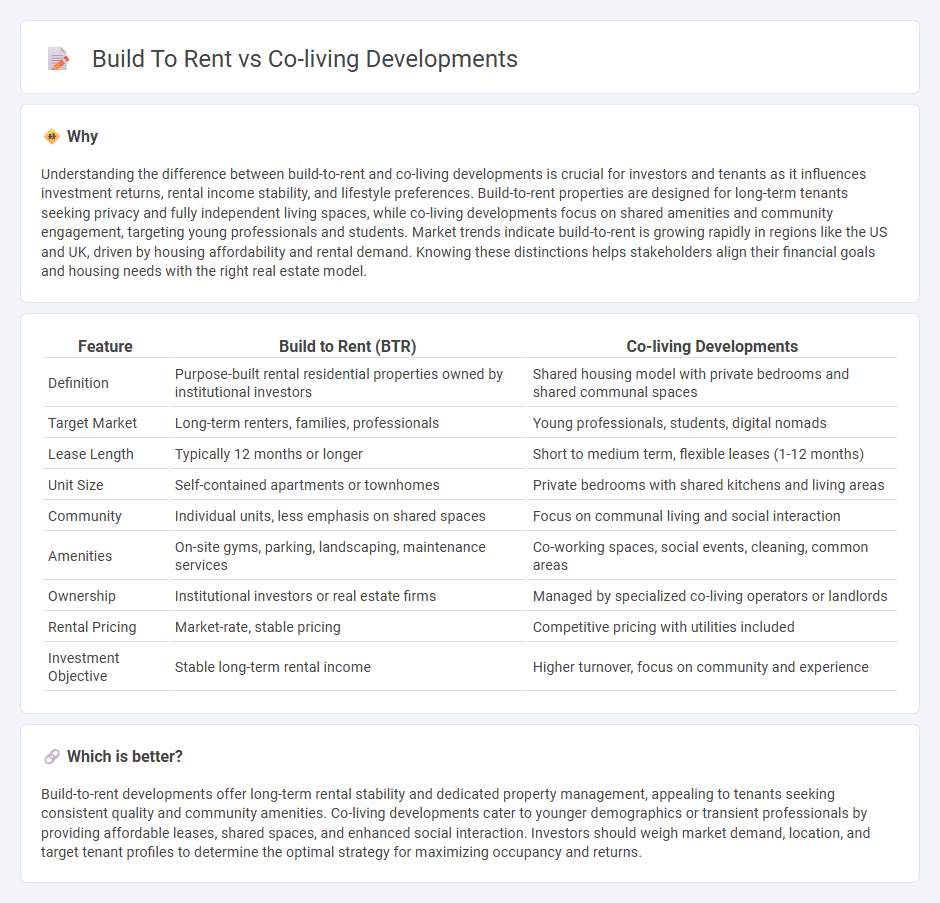
Build-to-rent developments focus on purpose-built rental properties designed for long-term tenants, providing standardized amenities and professional management. Co-living developments offer shared living spaces with communal areas, targeting renters seeking affordable housing and social interaction. Explore the key differences and benefits of build-to-rent and co-living to find the best fit for your investment or lifestyle needs.
Why it is important
Understanding the difference between build-to-rent and co-living developments is crucial for investors and tenants as it influences investment returns, rental income stability, and lifestyle preferences. Build-to-rent properties are designed for long-term tenants seeking privacy and fully independent living spaces, while co-living developments focus on shared amenities and community engagement, targeting young professionals and students. Market trends indicate build-to-rent is growing rapidly in regions like the US and UK, driven by housing affordability and rental demand. Knowing these distinctions helps stakeholders align their financial goals and housing needs with the right real estate model.
Comparison Table
| Feature | Build to Rent (BTR) | Co-living Developments |
|---|---|---|
| Definition | Purpose-built rental residential properties owned by institutional investors | Shared housing model with private bedrooms and shared communal spaces |
| Target Market | Long-term renters, families, professionals | Young professionals, students, digital nomads |
| Lease Length | Typically 12 months or longer | Short to medium term, flexible leases (1-12 months) |
| Unit Size | Self-contained apartments or townhomes | Private bedrooms with shared kitchens and living areas |
| Community | Individual units, less emphasis on shared spaces | Focus on communal living and social interaction |
| Amenities | On-site gyms, parking, landscaping, maintenance services | Co-working spaces, social events, cleaning, common areas |
| Ownership | Institutional investors or real estate firms | Managed by specialized co-living operators or landlords |
| Rental Pricing | Market-rate, stable pricing | Competitive pricing with utilities included |
| Investment Objective | Stable long-term rental income | Higher turnover, focus on community and experience |
Which is better?
Build-to-rent developments offer long-term rental stability and dedicated property management, appealing to tenants seeking consistent quality and community amenities. Co-living developments cater to younger demographics or transient professionals by providing affordable leases, shared spaces, and enhanced social interaction. Investors should weigh market demand, location, and target tenant profiles to determine the optimal strategy for maximizing occupancy and returns.
Connection
Build to rent and co-living developments intersect by addressing the growing demand for affordable, flexible housing options in urban markets. Both models emphasize community-centric design, with build to rent providing professionally managed rental properties and co-living focusing on shared living spaces that enhance social interaction. These paradigms cater to millennials and young professionals seeking convenience, affordability, and a sense of community in high-density metropolitan areas.
Key Terms
**Co-living developments:**
Co-living developments emphasize shared communal spaces and social interaction, catering primarily to young professionals and digital nomads seeking affordable, flexible urban living options. These developments optimize space efficiency while fostering a sense of community through shared amenities like kitchens, lounges, and coworking areas. Explore how co-living models are transforming urban housing and creating connected, vibrant neighborhoods.
Shared Amenities
Co-living developments emphasize communal spaces such as fully equipped kitchens, lounges, and coworking areas designed to foster social interaction among residents. Build-to-rent properties prioritize private amenities like in-unit washers, gyms, and secure parking to enhance individual convenience within a rental community. Explore detailed comparisons to understand which model best suits your lifestyle preferences and investment goals.
Community Engagement
Co-living developments emphasize shared spaces and communal activities to foster strong community engagement among residents, promoting social interaction and collaboration. Build to rent projects focus on providing private living units with amenities designed to enhance convenience, often integrating community events to increase tenant satisfaction and retention. Explore the unique approaches of both models to understand which best supports vibrant, connected living experiences.
Source and External Links
How Co-Living Is Reshaping Urban Housing - Co-living addresses evolving renter needs by combining affordability, security, and community-centric living, blending privacy with sociability in urban areas.
Co-living Design Study - MVRDV - This study explores innovative co-living typologies that respond to societal changes and challenges like climate change, affordability, and community building in housing.
What Is Co-Living Housing and Why Is It on the Rise? - Co-living is gaining popularity mainly due to rising housing costs, changing renter lifestyles prioritizing location and amenities, and a growing desire for community and social connection.
 dowidth.com
dowidth.com